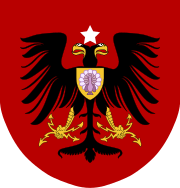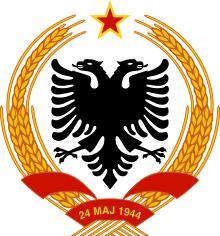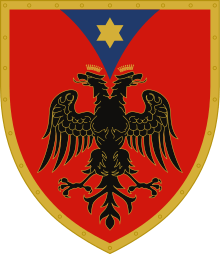Coat of arms of Albania
The coat of arms of Albania (Albanian: Stema e Shqipërisë) is an adaptation of the flag of Albania. It is based on the flag and seal of Gjergj Kastriot Skanderbeg. The emblem above the head of the two-headed eagle is the helmet of Skanderbeg, surmounted with billy goats' horns. The eagle is considered to violate the conventional rule of tincture, which forbids placing a colour (i.e. a dark tincture) upon another colour.
| Coat of arms of Albania | |
|---|---|
 | |
| Armiger | Republic of Albania |
| Adopted | 2002: standardized by Law #8926, 22 July 2002 |
Official description
Albanian law describes the coat of arms as follows:[1]
The Coat of the Republic of Albania is a state symbol. It displays a shield, colored blood red, with an eagle in the center, the same as the eagle of the national flag of the Republic of Albania. On top of the shield, in gold color, is Gjergj Kastioti's helm, shown in right profile. The shield's dimensions have a 1:1.5 ratio.
Significance of the helmet

Skanderbeg's helmet is made of white metal, adorned with a strip dressed in gold. On its top lies the head of a horned goat made of bronze, also dressed in gold. The bottom part bears a copper strip adorned with a monogram separated by rosettes: * IN * PE * RA * TO * RE * BT *, standing for Iesus Nazarenus * Principi Emathie * Regi Albaniae * Terrori Osmanorum * Regi Epirotarum * Benedictat Te (Jesus the Nazarene Blesses Thee, Prince of Mat, King of Albania, Terror of the Ottomans, King of Epirus).
The inscriptions on the helmet may refer to the unsettled name by which Albania was known at the time, as a means to identify Skanderbeg's leadership over all Albanians across regional denominative identifications. Contemporary sources show that 14th century Albanians were invariably identified as a tribal peoples, with no state of their own. Thus, depending on where they lived – North or South, in the plains or in the mountains, and to which civilization they subscribed to - we have Turkish Arnauts, Greek Arbanites or Albanoi, Albanian Arber, Arben, Arberesh, Epirotas.[2]
According to a report by historian Shefqet Pllana, Sami Frasheri in his Kamus-al-Alam maintains that the wording "Dhu lKarnejn" (owner of the two horns) was an appellative attributed to Alexander the Great of Macedon, the very name which Skanderbeg bore in the Islamic form. This second explanation may not be the truer, since the theory of the Macedonian-Albanian and Epirot-Albanian continuance is strong among Albanians but not among all the peoples of Europe. This opinion agrees with the work of Marin Barleti who writes: "When the people saw all those young and brave men around Skanderbeg, then it was not hard to believe that the armies of [Sultan] Murat were so defeated by the Albanians. Indeed, the times when the star of Macedon shone brilliantly had returned, just as they seemed in those long forgotten times of Pyrrhus and Alexander."
Historical coats of arms
 Coat of arms of the Angevin dynasty used by Kingdom of Albania (1272–1368)
Coat of arms of the Angevin dynasty used by Kingdom of Albania (1272–1368) Coat of arms of the Principality of Albania (1914–1925)
Coat of arms of the Principality of Albania (1914–1925).svg.png) Coat of arms of the Albanian Republic (1925–28)
Coat of arms of the Albanian Republic (1925–28).svg.png) Coat of arms of the Albanian Kingdom (1928–1939)
Coat of arms of the Albanian Kingdom (1928–1939).svg.png) Coat of arms of Albania under Italy (1939–1943)
Coat of arms of Albania under Italy (1939–1943) Emblem of the People's Republic of Albania (1946–1991)
Emblem of the People's Republic of Albania (1946–1991).svg.png) Coat of arms of Albania (1992–1998)
Coat of arms of Albania (1992–1998).svg.png) Coat of arms of Albania (1998–2002)
Coat of arms of Albania (1998–2002) Coat of arms of Albania (2002–current)
Coat of arms of Albania (2002–current) The coat of arms of the Kastrioti noble family. (1444–1479)
The coat of arms of the Kastrioti noble family. (1444–1479)
Other
.svg.png) Standard of the Sovereign Prince William of Albania
Standard of the Sovereign Prince William of Albania.svg.png) Standard of the Sovereign Princess Sophie of Albania
Standard of the Sovereign Princess Sophie of Albania.svg.png) Standard of the Hereditary Prince Carol Victor of Albania
Standard of the Hereditary Prince Carol Victor of Albania Insignia of the Royal Albanian Army
Insignia of the Royal Albanian Army
References
- Ligj Nr. 8926
- Schmitt, Oliver Jens . "Arberia Vendike (1392-1479)" [Das Venezianische Albanien (1392–1479)]. Tirane: K&B, 2007. 63–85.
External links
| Wikimedia Commons has media related to National coats of arms of Albania. |